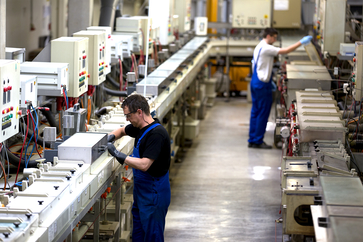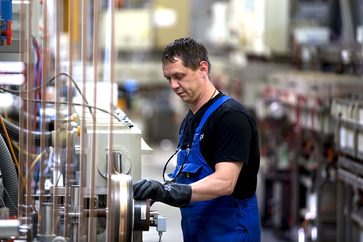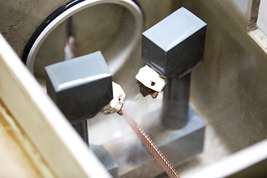How does electroplating work at ept Gmbh?
How does the surface coating of connector contacts work?

Headquartered in Peiting, Germany, ept GmbH is a full-service provider for PCB connectors and has acces to all of the necessary technologies for producing connectors in-house. These range from plastic injection molding for insulators, to stamping contacts made from metal strips, to assembling and combining individual elements and finally to the production of the finished plug connector.
ept also has strip electroplating technology, necessary for coating contact pins with various metal finishes, in its Peiting and Augsburg facilities. These locations combine a total of four strip electroplating lines on two systems. The newest system in Augsburg even has two separate tracks, which allows two different products to be finished simultaneously. While the Peiting site processes contacts for use in industrial electronics, telecommunications and automotive applications, the facility in Augsburg focuses exclusively on components for the automotive sector.
ept also has strip electroplating technology, necessary for coating contact pins with various metal finishes, in its Peiting and Augsburg facilities. These locations combine a total of four strip electroplating lines on two systems. The newest system in Augsburg even has two separate tracks, which allows two different products to be finished simultaneously. While the Peiting site processes contacts for use in industrial electronics, telecommunications and automotive applications, the facility in Augsburg focuses exclusively on components for the automotive sector.
30 Years of Experience in Electroplating
ept invested in its first electroplating system back in 1985. Thanks to the boom in the telecommunications industry and the accompanying high demand for connectors in this sector, the company brought a second system into operation just five years later. During this period, ept significantly expanded its experience and expertise in the field of strip electroplating. This was followed by a transition from surface coatings containing pure palladium to palladium-nickel and nickel-phosphorous coatings as well as the introduction of various stripping technologies. Additional upgrades implemented during this time still benefit the company today. This includes improvements made to its washing technology and the optimization of the guiding system.
What is strip galvanization?
Strip electroplating refers to the process of galvanizing wires, solid strips (e.g. made of copper alloys or brass), and – in the case of connectors – banded or stamped contacts in continuous feed systems. This process is very efficient, because mass-produced components in particular can be coated in a short period of time and with a high level of quality thanks to the use of continuous processes. Plus, the components passing through the system can also be coated on a selective basis, which in turn saves materials and costs.
How does strip electroplating work?
Before a product is run through the electroplating system, the corresponding formula is loaded and the various baths are prepared. Following a test run, the result is measured and inspected before the actual production process can begin. Directly after production begins, an initial component measurement is also carried out, followed by ongoing visual and flexure checks as well as camber and twist/bulge measurements at the end of every reel. Thanks to several deflection rollers for winding and unwinding the stamped metal strip, buffers at the beginning and end of every strip electroplating line ensure that the system doesn’t come to a standstill while the strip is being changed. Deflecting the strip gives the person operating the system around four minutes of time to change the reels.


After being unwound from the reel, the strip first runs through various degreasing and rinsing baths and is then prepared for the actual coating in an activation bath. In the subsequent baths, the contacts can be coated with various non-precious metals and finally with precious metals by means of electrolysis. The thickness of the coating can be controlled via the speed of the strip: the longer the strip remains in a bath, the thicker the coating of material that is applied. Depending on the type of contacts being produced, the strips measure between 100 and 600 meters long and pass through the system at a speed of up to 10 meters per minute.
Before the finished galvanized strip is rolled back onto the reel at the end of the line, it also passes through a hot air oven and finally through an inspection cell.
Before the finished galvanized strip is rolled back onto the reel at the end of the line, it also passes through a hot air oven and finally through an inspection cell.
Combining Environmental Awareness and Competitiveness
ept places very high value on restricting its environmental footprint to a minimum. This is both extremely important and challenging, especially when operating an electroplating system where chemical substances are being used. All of the wastewater produced by the electroplating systems at ept is treated and detoxified internally. The waste products that are removed undergo a recovery process. Water used for rinsing, meanwhile, flows through an ion exchange system as part of a closed cycle, where it is purified and returned to the electroplating system. Thanks to this method, the strip electroplating system consumes very little water. Even though the systems run seven days a week and around the clock, the use of this process results in the consumption of no more than 400 to 500 cubic meters of water per year. Each year, ept falls far short of the wastewater threshold values specified in legislation.
Reusable materials are also conserved: The water and the valuable substances it contains undergo a number of rinsing processes following the main bath. The reusable material is returned to the main bath in a cascade.
Any sludge produced is recycled by an external company, and the residues that are filtered out, such as nickel and tin, are processed into new pellets and recovered.
Virtually no waste is produced at ept: Everything is recycled and reprocessed as part of a cycle.
Companies that focus on efficient production methods don’t just save water and resources, but cash as well – and ensure that they remain competitive. ept recognized this fact and therefore invests heavily in efficient, eco-friendly production methods. Renewable energies also play an important part. To this end, the company made the switch from electric heating to heat exchangers in its electroplating systems. It also uses its own cogeneration unit to produce the energy required for the systems themselves.
Frequency-controlled pumps, low-pressure compressors, and special neon lights greatly reduce the amount of power required
Reusable materials are also conserved: The water and the valuable substances it contains undergo a number of rinsing processes following the main bath. The reusable material is returned to the main bath in a cascade.
Any sludge produced is recycled by an external company, and the residues that are filtered out, such as nickel and tin, are processed into new pellets and recovered.
Virtually no waste is produced at ept: Everything is recycled and reprocessed as part of a cycle.
Companies that focus on efficient production methods don’t just save water and resources, but cash as well – and ensure that they remain competitive. ept recognized this fact and therefore invests heavily in efficient, eco-friendly production methods. Renewable energies also play an important part. To this end, the company made the switch from electric heating to heat exchangers in its electroplating systems. It also uses its own cogeneration unit to produce the energy required for the systems themselves.
Frequency-controlled pumps, low-pressure compressors, and special neon lights greatly reduce the amount of power required
Process optimization
Processes can also be optimized to make them more efficient. One example is the electroplating department’s analysis lab, which was recently fitted with a sophisticated automatic analyzer that saves employees two to four hours of work each week. This helps the company manage rising costs involved in the analysis process, which have increased continually in recent years due to increasingly stricter requirements being placed on its products. Modern software and networked databases also enable almost completely digital monitoring of the electroplating system and display, for example, the fill level and temperature of the baths.
However, ept also promotes efforts to protect the environment through its selection of materials as well as special process technologies during electroplating. For example, the direct contact surfaces of contacts are only finished with valuable coatings such as gold on a selective basis wherever possible. In addition, palladium – a rare metal – in some cases can be replaced by a nickel-phosphorous coating developed by the company itself. This saves resources and reduces waste. ept is also currently working on a lead-free, environmentally friendly alternative to the tin-lead coating that has been indispensable in some applications thus far.
However, ept also promotes efforts to protect the environment through its selection of materials as well as special process technologies during electroplating. For example, the direct contact surfaces of contacts are only finished with valuable coatings such as gold on a selective basis wherever possible. In addition, palladium – a rare metal – in some cases can be replaced by a nickel-phosphorous coating developed by the company itself. This saves resources and reduces waste. ept is also currently working on a lead-free, environmentally friendly alternative to the tin-lead coating that has been indispensable in some applications thus far.
The Future of Electroplating at ept
ept has experienced strong growth around the world in recent years: Sales increased by 63% to 132 million euros per year just between 2014 and 2017, and over 100 employees joined ept’s headquarters in Peiting alone. This has increased the current number of employees at ept to well over 1,100.
ept continues to expand in order to meet its ever-growing demand: The main plant in Peiting is now being extended following upgrades to the ept sites in Buching, the Czech Republic, and the U.S. among other things, the company is also planning an expansion of the electroplating department to include another electronically controlled system. It is also investing in its existing systems, including renovations to its ion exchange and wastewater treatment systems, for example.
Still, even without this expansion, the electroplating department at ept needs more staff. Four qualified surface coating specialists are currently being sought after for the Peiting location alone. Around thirty new employees will be required in Augsburg due to the expansion of the strip electroplating lines by the end of 2019.
And ept is also training surface coating specialists in order to address the shortage of specialists that is prevalent everywhere. Two apprentices will be completing their vocational training in the electroplating department this year. There are plans to offer even more apprenticeships in this area in the future. Because the apprentices learn about a very specific area of electroplating technology at ept, they are also sent to other companies during their training. This allows them to acquire knowledge about other areas of surface coating in addition to strip electroplating. ept hopes to be able to get a growing number of young people interested in this exciting training profession in the future and thereby ensure that its team of expert employees continues to grow.
ept continues to expand in order to meet its ever-growing demand: The main plant in Peiting is now being extended following upgrades to the ept sites in Buching, the Czech Republic, and the U.S. among other things, the company is also planning an expansion of the electroplating department to include another electronically controlled system. It is also investing in its existing systems, including renovations to its ion exchange and wastewater treatment systems, for example.
Still, even without this expansion, the electroplating department at ept needs more staff. Four qualified surface coating specialists are currently being sought after for the Peiting location alone. Around thirty new employees will be required in Augsburg due to the expansion of the strip electroplating lines by the end of 2019.
And ept is also training surface coating specialists in order to address the shortage of specialists that is prevalent everywhere. Two apprentices will be completing their vocational training in the electroplating department this year. There are plans to offer even more apprenticeships in this area in the future. Because the apprentices learn about a very specific area of electroplating technology at ept, they are also sent to other companies during their training. This allows them to acquire knowledge about other areas of surface coating in addition to strip electroplating. ept hopes to be able to get a growing number of young people interested in this exciting training profession in the future and thereby ensure that its team of expert employees continues to grow.


